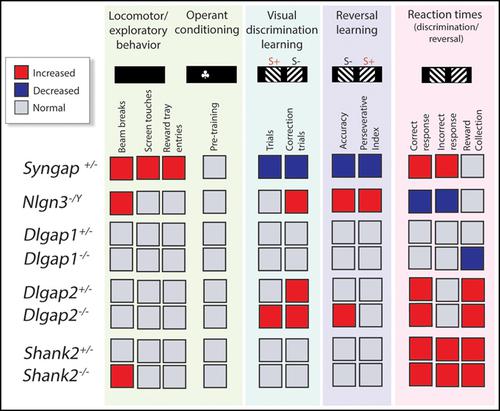当前位置:
X-MOL 学术
›
Genes Brain Behav.
›
论文详情
Our official English website, www.x-mol.net, welcomes your
feedback! (Note: you will need to create a separate account there.)
Learning and reaction times in mouse touchscreen tests are differentially impacted by mutations in genes encoding postsynaptic interacting proteins SYNGAP1, NLGN3, DLGAP1, DLGAP2 and SHANK2
Genes, Brain and Behavior ( IF 2.4 ) Pub Date : 2020-12-21 , DOI: 10.1111/gbb.12723 Alexa E Horner 1 , Rebecca H Norris 2 , Robbie McLaren-Jones 1 , Liam Alexander 1 , Noboru H Komiyama 3, 4 , Seth G N Grant 3, 4 , Jess Nithianantharajah 2 , Maksym V Kopanitsa 1, 5
Genes, Brain and Behavior ( IF 2.4 ) Pub Date : 2020-12-21 , DOI: 10.1111/gbb.12723 Alexa E Horner 1 , Rebecca H Norris 2 , Robbie McLaren-Jones 1 , Liam Alexander 1 , Noboru H Komiyama 3, 4 , Seth G N Grant 3, 4 , Jess Nithianantharajah 2 , Maksym V Kopanitsa 1, 5
Affiliation

|
The postsynaptic terminal of vertebrate excitatory synapses contains a highly conserved multiprotein complex that comprises neurotransmitter receptors, cell‐adhesion molecules, scaffold proteins and enzymes, which are essential for brain signalling and plasticity underlying behaviour. Increasingly, mutations in genes that encode postsynaptic proteins belonging to the PSD‐95 protein complex, continue to be identified in neurodevelopmental disorders (NDDs) such as autism spectrum disorder, intellectual disability and epilepsy. These disorders are highly heterogeneous, sharing genetic aetiology and comorbid cognitive and behavioural symptoms. Here, by using genetically engineered mice and innovative touchscreen‐based cognitive testing, we sought to investigate whether loss‐of‐function mutations in genes encoding key interactors of the PSD‐95 protein complex display shared phenotypes in associative learning, updating of learned associations and reaction times. Our genetic dissection of mice with loss‐of‐function mutations in Syngap1, Nlgn3, Dlgap1, Dlgap2 and Shank2 showed that distinct components of the PSD‐95 protein complex differentially regulate learning, cognitive flexibility and reaction times in cognitive processing. These data provide insights for understanding how human mutations in these genes lead to the manifestation of diverse and complex phenotypes in NDDs.
中文翻译:

小鼠触摸屏测试中的学习和反应时间受到编码突触后相互作用蛋白 SYNGAP1、NLGN3、DLGAP1、DLGAP2 和 SHANK2 的基因突变的不同影响
脊椎动物兴奋性突触的突触后末端含有高度保守的多蛋白复合物,其中包括神经递质受体、细胞粘附分子、支架蛋白和酶,它们对于大脑信号传导和潜在行为的可塑性至关重要。在自闭症谱系障碍、智力障碍和癫痫等神经发育障碍 (NDD) 中,越来越多地发现编码属于 PSD-95 蛋白复合物的突触后蛋白的基因突变。这些疾病具有高度异质性,具有共同的遗传病因以及共病的认知和行为症状。在这里,通过使用基因工程小鼠和创新的基于触摸屏的认知测试,我们试图研究编码 PSD-95 蛋白复合物关键相互作用子的基因中的功能丧失突变是否在联想学习、学习关联更新和反应时间。我们对Syngap1 、 Nlgn3 、 Dlgap1 、 Dlgap2和Shank2发生功能丧失突变的小鼠进行基因剖析,结果表明 PSD-95 蛋白复合物的不同成分对认知处理中的学习、认知灵活性和反应时间有差异性调节。这些数据为理解人类这些基因突变如何导致 NDD 表现出多样化和复杂的表型提供了见解。
更新日期:2021-01-21
中文翻译:

小鼠触摸屏测试中的学习和反应时间受到编码突触后相互作用蛋白 SYNGAP1、NLGN3、DLGAP1、DLGAP2 和 SHANK2 的基因突变的不同影响
脊椎动物兴奋性突触的突触后末端含有高度保守的多蛋白复合物,其中包括神经递质受体、细胞粘附分子、支架蛋白和酶,它们对于大脑信号传导和潜在行为的可塑性至关重要。在自闭症谱系障碍、智力障碍和癫痫等神经发育障碍 (NDD) 中,越来越多地发现编码属于 PSD-95 蛋白复合物的突触后蛋白的基因突变。这些疾病具有高度异质性,具有共同的遗传病因以及共病的认知和行为症状。在这里,通过使用基因工程小鼠和创新的基于触摸屏的认知测试,我们试图研究编码 PSD-95 蛋白复合物关键相互作用子的基因中的功能丧失突变是否在联想学习、学习关联更新和反应时间。我们对Syngap1 、 Nlgn3 、 Dlgap1 、 Dlgap2和Shank2发生功能丧失突变的小鼠进行基因剖析,结果表明 PSD-95 蛋白复合物的不同成分对认知处理中的学习、认知灵活性和反应时间有差异性调节。这些数据为理解人类这些基因突变如何导致 NDD 表现出多样化和复杂的表型提供了见解。










































 京公网安备 11010802027423号
京公网安备 11010802027423号